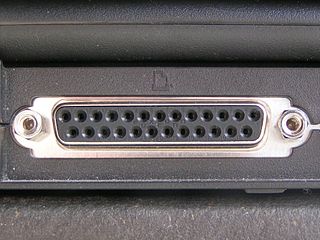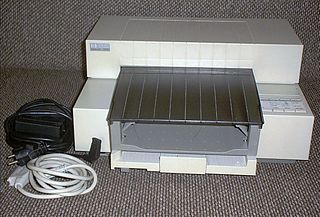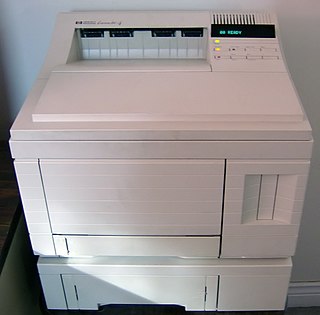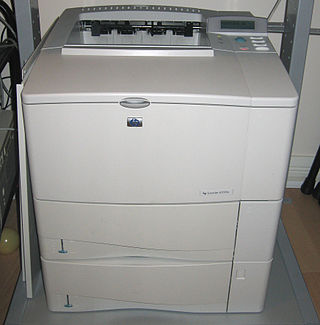
The HP LaserJet 1020 is a low cost, low volume, monochromatic laser printer. It was a replacement for the HP LaserJet 1012. The production started in June 2005. [1]

The HP LaserJet 1020 is a low cost, low volume, monochromatic laser printer. It was a replacement for the HP LaserJet 1012. The production started in June 2005. [1]
In contrast to less compact, more powerful, laser printers, it only exposes ZjStream externally.
The LaserJet 1020 was studied to determine particulate emission and its potential effects on health. The 1020 was found to be a moderate emitter of particulates. A full copy of the report can be found here, whereas HP's response can be found here.
It uses a black toner print cartridge number Q2612A [2] with 2,000-page capacity [3] at the standard five percent coverage.

In computing, a printer is a peripheral machine which makes a persistent representation of graphics or text, usually on paper. While most output is human-readable, bar code printers are an example of an expanded use for printers. Different types of printers include 3D printers, inkjet printers, laser printers, and thermal printers.

PostScript (PS) is a page description language in the electronic publishing and desktop publishing realm. It is a dynamically typed, concatenative programming language. It was created at Adobe Systems by John Warnock, Charles Geschke, Doug Brotz, Ed Taft and Bill Paxton from 1982 to 1984.
In digital printing, a page description language (PDL) is a computer language that describes the appearance of a printed page in a higher level than an actual output bitmap. An overlapping term is printer control language, which includes Hewlett-Packard's Printer Command Language (PCL). PostScript is one of the most noted page description languages. The markup language adaptation of the PDL is the page description markup language.

Laser printing is an electrostatic digital printing process. It produces high-quality text and graphics by repeatedly passing a laser beam back and forth over a negatively charged cylinder called a "drum" to define a differentially charged image. The drum then selectively collects electrically charged powdered ink (toner), and transfers the image to paper, which is then heated to permanently fuse the text, imagery, or both, to the paper. As with digital photocopiers, laser printers employ a xerographic printing process. Laser printing differs from traditional xerography as implemented in analog photocopiers in that in the latter, the image is formed by reflecting light off an existing document onto the exposed drum.

Inkjet printing is a type of computer printing that recreates a digital image by propelling droplets of ink onto paper and plastic substrates. Inkjet printers were the most commonly used type of printer in 2008, and range from small inexpensive consumer models to expensive professional machines. By 2019, laser printers outsold inkjet printers by nearly a 2:1 ratio, 9.6% vs 5.1% of all computer peripherals.

The LaserWriter is a laser printer with built-in PostScript interpreter sold by Apple, Inc. from 1985 to 1988. It was one of the first laser printers available to the mass market. In combination with WYSIWYG publishing software like PageMaker, that operated on top of the graphical user interface of Macintosh computers, the LaserWriter was a key component at the beginning of the desktop publishing revolution.

Daisy wheel printing is an impact printing technology invented in 1970 by Andrew Gabor at Diablo Data Systems. It uses interchangeable pre-formed type elements, each with typically 96 glyphs, to generate high-quality output comparable to premium typewriters such as the IBM Selectric, but two to three times faster. Daisy wheel printing was used in electronic typewriters, word processors and computers from 1972. The daisy wheel is so named because of its resemblance to the daisy flower.

In computing, a parallel port is a type of interface found on early computers for connecting peripherals. The name refers to the way the data is sent; parallel ports send multiple bits of data at once, as opposed to serial communication, in which bits are sent one at a time. To do this, parallel ports require multiple data lines in their cables and port connectors and tend to be larger than contemporary serial ports, which only require one data line.

Toner is a powder mixture used in laser printers and photocopiers to form the printed text and images on paper, in general through a toner cartridge. Mostly granulated plastic, early mixtures added only carbon powder and iron oxide, however, mixtures have since been developed containing polypropylene, fumed silica, and various minerals for triboelectrification. Toner using plant-derived plastic also exists as an alternative to petroleum plastic. Toner particles are melted by the heat of the fuser, and are thus bonded to the paper.

Deskjet is a brand name for inkjet printers manufactured by Hewlett-Packard. These printers range from small domestic to large industrial models, although the largest models in the range have generally been dubbed DesignJet. The Macintosh-compatible equivalent was branded as the Deskwriter and competed with Apple's StyleWriter, and the all-in-one equivalent is called OfficeJet.

LaserJet as a brand name identifies the line of laser printers marketed by the American computer company Hewlett-Packard (HP). The HP LaserJet was the world’s first desktop laser printer. Canon supplies both mechanisms and cartridges for most HP laser printers; some larger A3 models use Samsung print engines.
The StyleWriter brand is a line of inkjet serial printers by Apple, targeted mainly towards consumers. They produced print quality that was better than the dot matrix ImageWriters, and were cheaper than the LaserWriters. All but a few models contained Canon print engines, while the last few were re-badged HP DeskJet printers. When Steve Jobs returned to Apple in 1997, he discontinued most of the company's accessory product lines, including the StyleWriter and LaserWriter.
Printer Command Language, more commonly referred to as PCL, is a page description language (PDL) developed by Hewlett-Packard as a printer protocol and has become a de facto industry standard. Originally developed for early inkjet printers in 1984, PCL has been released in varying levels for thermal, matrix, and page printers. HP-GL/2 and PJL are supported by later versions of PCL.

The HP LaserJet 4 is a group of monochrome laser printers produced in the early to mid-1990s as part of the LaserJet series by Hewlett-Packard (HP). The 4 series has various models, including the standard LaserJet 4 for business use, the 4L for personal use and the 4P for small businesses. Additional models included the 4Si model, created as a heavy-duty business printer, and the 4V model, a B-size printer for desktop publishing and graphic artists. There are also PostScript variants of these machines with the '4M' designation, where M stands for, but is not limited to, usage with an Apple Macintosh. Hewlett-Packard also released an upgraded version of the LaserJet 4/4M known as the 4 Plus ('4+')/4M Plus ('4M+').

Qume was a manufacturer of daisy-wheel printers originally located in Hayward, California, later moving to San Jose. Around 1980, it also opened a manufacturing facility in Puerto Rico. It once dominated the daisy-wheel market. As the market for its printers declined in the 1980s, the company developed a line of computer terminals. It was founded by David S. Lee and Robert E. Schroeder in 1973, grew to become the largest printer company in the world, and was acquired by ITT Corporation for an unprecedented $164M in 1978. It remained a division of ITT until its acquisition by Wyse Technology sometime before 1995. Qume also manufactured floppy diskette drives, particularly 5.25" ones, but it also manufactured 8" diskette drives as well. Qume's diskette drives were included in some IBM PC models, such as the Portable Personal Computer and PCjr.

The LaserJet 4000 series is Hewlett-Packard's medium-duty monochrome laser printer range and the successor to the LaserJet 5 series.
The Laserjet 2300 series was a line of grayscale laser printers sold by Hewlett-Packard. The printer was aimed at small and medium business use. The printer utilizes DRAM memory technology and uses 32 MB standard memory, which is expandable to 288 MB. It is compatible with Microsoft Windows and Macintosh Operating System.

The IBM 3800 is a discontinued continuous forms laser printer designed and manufactured by IBM. It is significant as a product because it was both the first laser printer manufactured by IBM, and the first commercially available continuous forms laser printer.

A variety of processes, equipment, and materials are used in the production of a three-dimensional object via additive manufacturing. 3D printing is also known as additive manufacturing, therefore the numerous available 3D printing process tend to be additive in nature with a few key differences in the technologies and the materials used in this process.